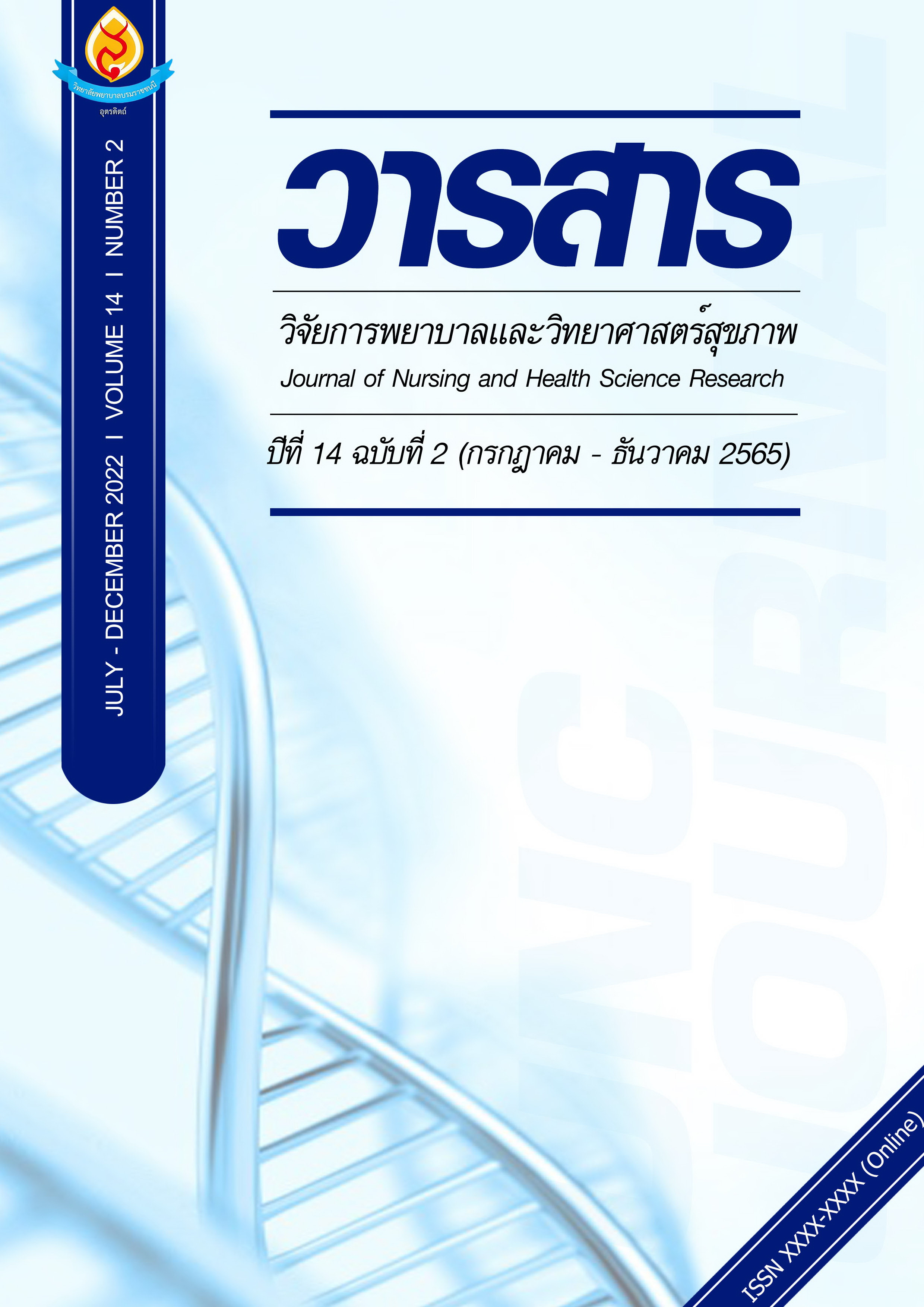การฆ่าตัวตายในวัยรุ่นจากการถูกกลั่นแกล้งทางไชเบอร์: การทบทวนวรรณกรรมอย่างเป็นระบบ
Main Article Content
บทคัดย่อ
การถูกกลั่นแกล้งทางไซเบอร์เป็นสาเหตุสำคัญของการฆ่าตัวตายที่มีแนวโน้มเพิ่มสูงขึ้นอย่างต่อเนื่องในวัยรุ่น การศึกษาอุบัติการณ์ ผลกระทบ ปัจจัยที่เกี่ยวข้องและแนวทางการประเมินความเสี่ยงมีความสำคัญอย่างยิ่งต่อการดูแลช่วยเหลือและป้องกันปัญหา การทบทวนวรรณกรรมอย่างเป็นระบบครั้งนี้มีวัตถุประสงค์เพื่อรวบรวมหลักฐานเชิงประจักษ์เกี่ยวกับการฆ่าตัวตายในวัยรุ่นจากการถูกกลั่นแกล้งทางไซเบอร์ จากรายงานการวิจัยที่สืบค้นทั้งที่ตีพิมพ์และไม่ได้ตีพิมพ์ ทั้งภาษาไทยและภาษาอังกฤษตั้งแต่ปี พ.ศ.2553-2563 จากฐานข้อมูล Google scholar, CINAHL, Scopus, Science direct, และฐานข้อมูลวิทยานิพนธ์ไทย ใช้แนวทางการทบทวนวรรณกรรมอย่างเป็นระบบของสถาบันโจแอนนาบริกส์ (Joan Briggs) คัดเลือกรายงานการวิจัยทั้งเชิงคุณภาพและเชิงปริมาณตามแบบประเมินงานวิจัยตามเกณฑ์การคัดเลือกที่ผู้วิจัยพัฒนาขึ้น พบงานวิจัยที่ศึกษาเกี่ยวกับการฆ่าตัวตายในวัยรุ่นจากการถูกกลั่นแกล้งทางไซเบอร์จำนวนทั้งหมด 279 เรื่อง ผ่านเกณฑ์การคัดเลือกตามคุณสมบัติที่กำหนดซึ่งเป็นการศึกษาเชิงปริมาณจำนวน 11 เรื่อง และการวิจัยแบบผสมผสานจำนวน 1 เรื่อง
ผลการทบทวนงานวิจัยอย่างเป็นระบบพบประเด็นสำคัญ ประกอบด้วย 1) อุบัติการณ์การถูกกลั่นแกล้งทางไซเบอร์พบมากที่สุดในช่วงอายุ 10-19 ปี 1 ใน 3 ของวัยรุ่นเคยตกเป็นเหยื่อของการกลั่นแกล้งทางไซเบอร์ รูปแบบการกลั่นแกล้ง คือ การถูกนินทา การด่าทอ เพศหญิงถูกกลั่นแกล้งในลักษณะโจมตี ข่มขู่ คุกคามทางเพศถูกบันทึกและเผยแพร่ข้อมูลออนไลน์ในลักษณะให้ร้าย 2) ผลกระทบ วัยรุ่นที่ตกเป็นเหยื่อของการถูกกลั่นแกล้งทางไซเบอร์มีความสัมพันธ์อย่างมีนัยสำคัญทางสถิติต่อการคิดฆ่าตัวตาย การพยายามฆ่าตัวตาย การเกิดภาวะซึมเศร้า ความวิตกกังวล ปัญหาสุขภาพจิตอื่น ๆ รวมทั้งการใช้สารเสพติด ความชุกของความคิดและความพยายามฆ่าตัวตายจากการถูกกั่นแกล้งทางไซเบอร์ และความเสี่ยงในการฆ่าตัวตายขึ้นอยู่กับความรุนแรงของการถูกกลั่นแกล้งทางไซเบอร์ 3) ปัจจัยที่เกี่ยวข้อง ได้แก่ อายุ เชื้อชาติ และเพศ วัยรุ่นที่มีอายุมากกว่ามีรายงานการฆ่าตัวตายสูงกว่า นักเรียนผิวขาวมีแนวโน้มของการพยายามฆ่าตัวตายสูงกว่า เพศหญิงตกเป็นเหยื่อของความรุนแรงมากกว่าเพศชาย และ 4) แบบประเมินการถูกกลั่นแกล้งทางไซเบอร์ที่นิยมนำมาใช้ คือ Young Internet Addiction Test (YIAT), Young’s Diagnostic Questionnaire (YDQ), Chen Internet Addiction Scale, the Korean Internet Addiction, Social Networking Sites (SNS)
Article Details

อนุญาตภายใต้เงื่อนไข Creative Commons Attribution-NonCommercial-NoDerivatives 4.0 International License.
บทความหรือข้อคิดเห็นใดใดที่ปรากฏในวารสารวิจัยการพยาบาลและวิทยาศาสตร์สุขภาพ เป็นวรรณกรรมของผู้เขียน ซึ่งบรรณาธิการหรือสมาคมศิษย์เก่า ไม่จำเป็นต้องเห็นด้วย และบทความที่ได้รับการตีพิมพ์เผยแพร่ถือเป็นลิขสิทธิ์ของวารสารวิจัยการพยาบาลและวิทยาศาสตร์สุขภาพ
เอกสารอ้างอิง
Arango, A., Opperman, K. J., Gipson, P. Y., & King, C. A. (2016). Suicidal ideation and suicide attempts among youth who report bully victimization, bully perpetration and/or low social connetedness. Journal of Adolescence, 51, 19-29.
Bauman, S. (2014) Youth suicide and bullying: Challenges and strategies for prevention and intervention Bauman, S. (Eds). New York, NY: Oxford University Press.
Bauman, S., Toomey, R. B., & Walker, J. L. (2013). Associations among bullying, cyberbullying, and suicide in high school students. Journal of Adolescence, 36(2), 341–350.
Bonanno, R. A., & Hymel, S. (2013). Cyber bullying and internalizing difficulties: Above and beyond the impact of traditional forms of bullying, Journal of Youth Adolescent, 42, 685-697.
Centers for Disease Control and Prevention [CDC]. (2016). Definitions: self-directed violence. Retrieved (2020, November 9) from http://www.cdc.gov/ violence prevention /suicide/definitions.
Fahy, A. E., Stansfield, S. A., Smut, M., Smith, N. R., Cummins, S., & Clark, C. (2016). Longitudinal associations between cyberbullying involvement and adolescent mental health. Journal of Adolescent Health, 59, 502–509.
Hinduja, S., & Patchin, J. W. (2018). Connecting adolescent suicide to the severity of bullying and cyberbullying. Journal of School Violence. Retrieved (2020, November 9) from doi:10.1080/15388220.2018.1492417
John A., Glendenning, A. C., Marchant, A., Montgomery, P., Stewart, A., Wood, S., Lloyd, K., & Hawton, K. (2017). Self-harm, suicidal behaviors, and cyberbullying in children and young people: Systematic review. Journal of Medical Internet Research, 20(4), e129
Kim, S., Kimber, M., Boyle, M. H., & Georgiades, K. (2018). Sex differences in the association between cyberbullying victimization and mental health, substance use, and suicidal ideation in adolescents. The Canadian Journal of Psychaitry. Retrieved (2021, January 16) from doi:10.1177/07067 437118777 397
Lockwood, C., Porrit, K., Munn, Z., Rittenmeyer, L., Salmond, S., Bjerrum, M., Stannard, D. (2017). Joanna Briggs Institute Reviewer's Manual. The Joanna Briggs Institute. Retrieved (2021, January 20) from https://reviewersmanual.joannabriggs.org/
Massing-Schaffer, M., & Nesi, J. (2020). Cyber victimization and suicide risk in adolescence: An integrative model of social media and suicide theories. Adolescent Research Review, 5, 49-65.
Mitchell, S. M., Seegan, P. L., Roush, J. F., Brown, S. L., Sustaíta, M. A., & Cukrowicz, K. C. (2016). Retrospective cyberbullying and suicide ideation: The mediating roles of depressive symptoms, perceived burdensomeness, and thwarted belongingness. Journal of Interpersonal Violence, 33(16), 2602–2620. doi:10.1177/0886260516628291
Sampasa-Kanyinga, H., Dupuis, L. C., & Ray, R. (2015). Prevalence and correlates of suicidal ideation and attempts among children and adolescents. International Journal of Adolescenct Medicine and Health. doi:10.1515/ijamh-2015-0053
Sedgwick, R., Epstein, S., Dutta, R., & Ougrin, D. (2019). Social media, internet use and suicide attempts in adolescents. Child and Adolescent Psychiatry, 32(6), 534-541.
Smith, P.K. (2012). Cyberbullying and cyber aggression. In S.R. Jimerson, A. B. Nickerson, M. J., Mayer, and M.J. Furlong (Eds.), Handbook of school violence and school safety: International research and practice (pp.93-103). New York, NY:
Tokunaga, R.S. (2010). Following you home from school: A critical review and synthesis of research on cyberbullying victimization. Computers in Human Behavior, 26(3), 277- 287
Van Geel, Vedder, & Tanilon (2014) Relationship Between Peer Victimization, Cyberbullying, and Suicide in Children and Adolescents .The Journal of American Medical Association, 168(5),435-442. doi:10.1001.2013.4143
Williams, S. G., Langhinrichsen-Rohling, J., Wornell, C., & Finnegan, H. (2017). Adolescents transitioning to high school: Sex differences in bullying victimization associated with depressive symptoms, suicide ideation, and suicide attempts. The Journal of School Nursing, 33(6), 467-479.
Yen, C. F., Yang, P., Wang, P. W., Lin, H. C., Liu, T. L., Wu, Y. Y., et al., (2014). Association between school bullying levels/types and mental health problems among Taiwanese adolescents. Comprehensive Psychiatry, 55, 405-413.
Young, R., Subramanian, R., Miles, S., Hinnant, A., & Andsager, J. L. (2016). Social representation of cyberbullying and adolescent suicide: A Mixed-method analysis of news stories. Health Communication, 32(9), 1082–1092. doi:10.1080 /10410236.2016. 1214214.


